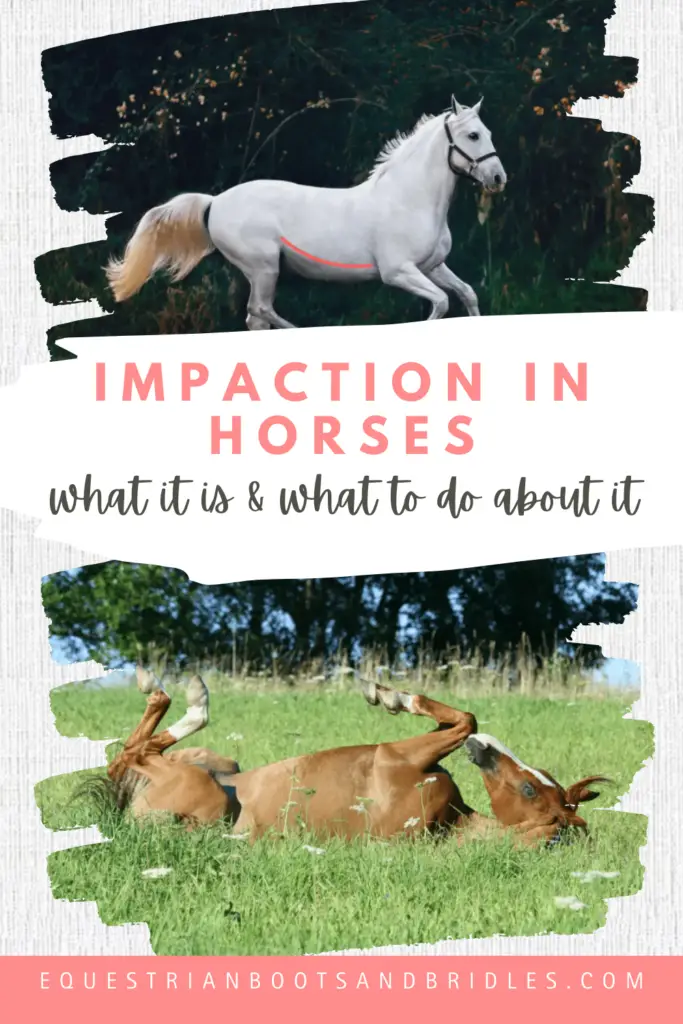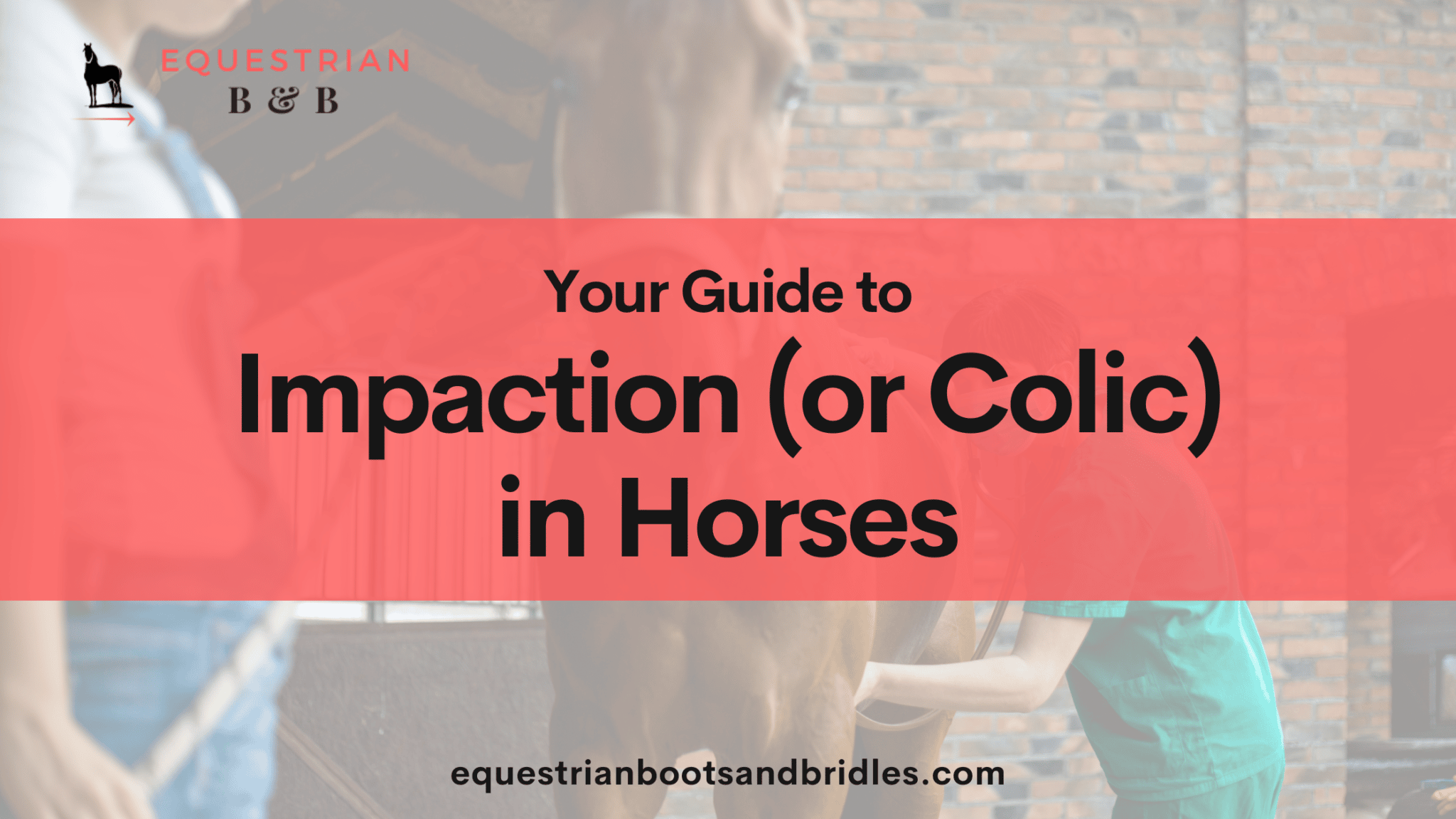For a horse owner, there is nothing worse than walking past your horse’s stall or paddock only to see them lying in a strange position, usually with their legs tucked under their bellies. Even to the untrained eye, it’s clear that there’s something not right with a horse that has impaction, also known as colic.
Colic is the number one killer of horses worldwide. That fact is enough to send chills down your spine if you are a horse owner. And it probably will make you want to learn everything you possibly can about impaction in horses.
So what is impaction colic, and why do horses get it? You’re about to find out all you’ve ever wanted to know about impaction in horses, how to identify it, what treatment options are available, and what to do when your horse is down. This knowledge could save your horse’s life.
As with any medical issues, you should always consult with your veteranarian for diagnosis and treatment. The contents of this article is for educational purposes only and is not meant to be official medical advice.
What Is Impaction Colic?
Impaction colic is essentially stomach cramps. That doesn’t sound so bad, does it? The problem is that horses aren’t wired the same as people are. Where we have relatively short digestive tracts, a horse’s digestive tract is about 70 feet in length, and their stomach is also quite small compared to other animals.
When food is too dry or the horse’s gut is dehydrated, the gut becomes “sticky” and the food bolus (food ball) gets stuck as it tries to move from the stomach to the colon. Of course, this is a simplified explanation, but that’s where the problems start.
Since the food is no longer able to move through the gut, any further food consumed will simply compress onto this, creating a plug that blocks the horse’s gut.
Constipation is the result, followed by a gassy void that forms in the gut behind the food plug.
A horse’s digestion doesn’t take place only in their stomach. They are hind gut fermentors, which means that most of the horse’s feed roughage is digested in the hind gut.
To do this, the horse’s intestinal tract is home to special bacteria that help the horse ferment and digest their food. When the balance becomes skewed due to the gassy void, the bacteria go into overdrive and more gas is produced, creating pressure on the entire intestinal tract and abdominal cavity.
When this stage is reached, the horse will suffer severe abdominal pain and contractions (also identified as heave lines down the length of the horse’s abdomen).

Why Do Horses Lie Down and Roll With Colic?
Due to the severe pressure and pain in the abdomen of the horse with impaction colic, they often lie down, easing pressure on their gut by supporting their gut on the ground. Unfortunately, this introduces the next threat to the horse, which is often what ends up killing them too.
Lying down doesn’t help the horse relieve the pain, so they start rolling. In an act of instinct, the horse tries to dislodge the intestinal blockage. Rolling doesn’t help, and the horse will eventually thrash around in pain, which twists their yards and yards of intestines.
If a bend forms in the intestinal tract, the horse has then suffered a potentially fatal complication that will require surgery to correct. The outlook for recovery from colic surgery isn’t always great.
The bend in the gut cuts off blood flow to the tissues of the gut, which then causes oxygen deprivation. In severe cases where the twist has gone untreated, the horse will begin to suffer oxygen deprivation, which you can see when their gums turn black or blue.
This is the point when the horse owner has to decide between euthanasia or surgery. Your vet should be an integral part of this journey, and you should call your vet long before your horse is in this final stage.
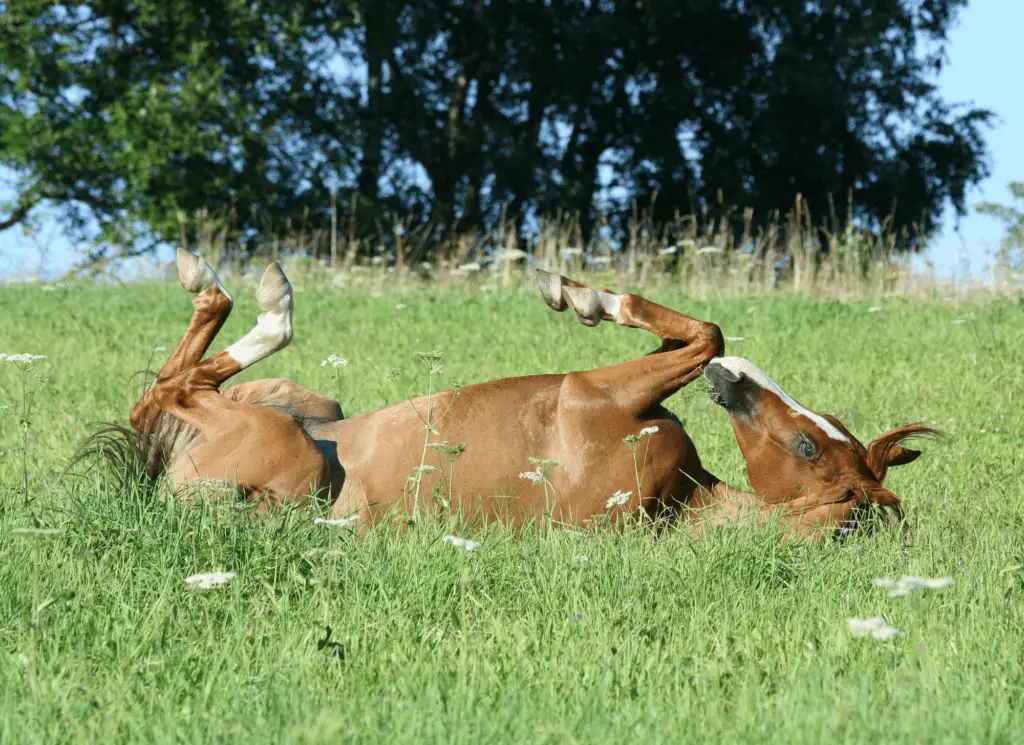
What Causes Impaction Colic?
Why do some horses never colic, while others seem to colic every week? Horse owners often ask why their horse is at risk of impaction colic. There are several causes of impaction colic in horses. Let’s look at them in more detail:
- Advanced Age
With older horses, their water intake tends to decrease, which causes gut dehydration. A horse with insufficient water consumption also tends to struggle with masticating their food, already forming a dry food mass from the mouth to the esophagus, into the stomach, and into the digestive system. Impaction colic is just a matter of time when a horse is dehydrated.
- Foreign Material in the Esophagus
For the most part, horses are great at finding things they shouldn’t eat and spitting them out, but the odd freaky accident does happen—like a horse that chews a length of baling twine and swallows it with their food. If you buy your food from a disreputable feed manufacturer, you run the risk of finding smaller foreign material particles in the feed that your horse may not even notice when eating.
Necropsies of horses that died from impaction colic often reveal strange material from plastic packets, glass fragments, metal shards, and balloons to shredded feed bags.
- Greedy Feeding and Overfeeding
Some horses are greedy feeders, and when their feed ration is placed in their trough or feed bowl, they scoff the feed. The result of this can be either choke or impaction colic when the food passes through the horse’s gut with too much pressure from overeating.
Horses only have the capacity to hold eight quarts to two gallons of fluid. When feeding, it’s vital that the horse isn’t overfed in a single meal as the extra food mass can trigger impaction colic. Greedy feeders tend to swallow without chewing, which sends dry food down to their stomach, causing blockages and even serration of the stomach and gut if the food particles are too big or sharp edged.
- Not Drinking Enough
Horses may also have insufficient water intake in winter when frozen buckets of water are inaccessible to the horse to drink. A horse should consume 5-10 gallons of fresh water per day to ensure good hydration and gut health.
- Sudden Feed Changes
Horses may often suffer impaction colic when they are moved from one area to a different part of the country or placed on a different feed type.
Experienced horse owners know to take hay from their regular supplier, as well as their feed concentrate, and then gradually transitioning the horse onto the new hay and feed.
Being in a completely different feeding situation with grazing may also trigger impaction colic. Transitioning from winter grazing to green spring grazing is also known to go hand in hand with colic and laminitis.
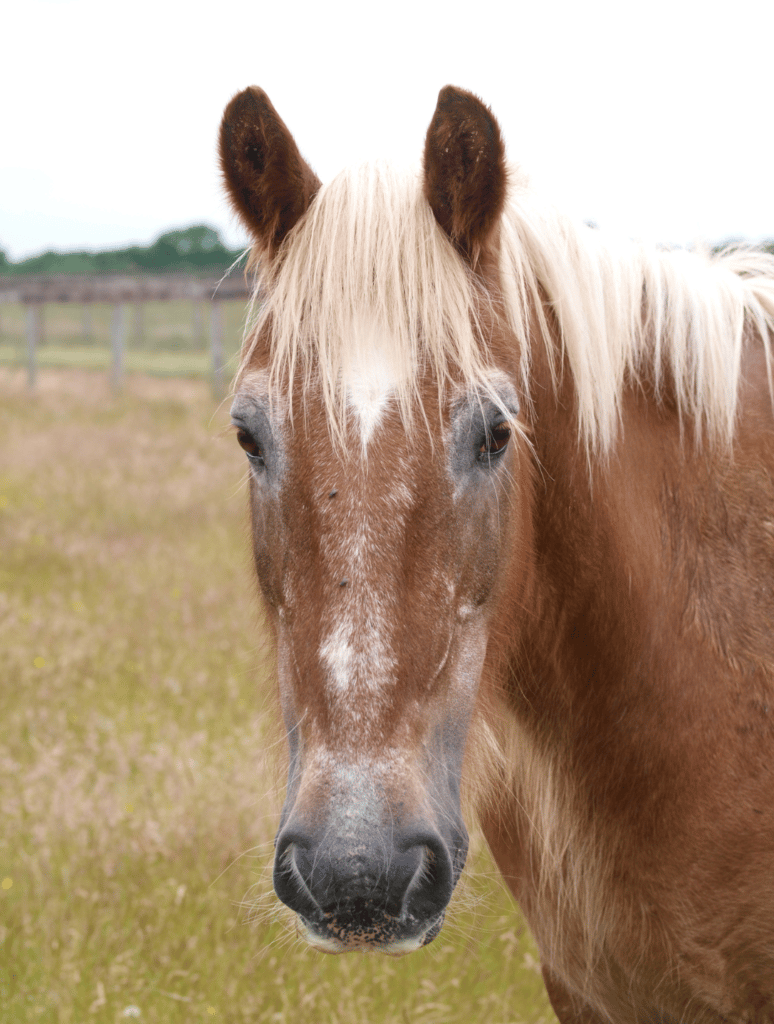
Identifying Signs of Impaction Colic
So what do you look for when you suspect your horse has impaction colic? There are a few signs that combine to create a clear picture, as well as putting you in the picture of what treatment to pursue. Look for the following:
- Sudden Decreased Appetite
A horse that refuses their regular concentrated feed is likely experiencing colic or has some other illness at play such as a viral infection.
- Physical Signs of Discomfort
When your horse stands with head lowered and legs slightly splayed, it’s a sign of discomfort. Combined with tail swishing, looking at their gut, kicking at the gut, pawing at the ground, and trying to lie down, you have a clear sign of impaction, sand, or gas colic.
These types of colic often go together, and the treatment is usually the same.
- Flehmen Reaction or Facial Contortion
Some horses exhibit their discomfort with flehmen responses where their upper lip curls back to reveal their teeth. Facial spasms and twisting of the upper lip may also be seen.
- Heave Lines on the Horse’s Abdomen
One of the classic signs of Impaction colic is when the horse has heave lines along their abdomen. This tucked in appearance is usually visible just before a horse attempts to lie down and roll. Severe impaction may also trigger the horse tucking their tail in and roaching their back.

6 Steps and Tips for Preventing Impaction Colic in Your Horse
If you have a horse that’s prone to colic, there are certain preventive measures you should take to reduce their risk of suffering impaction colic (or any kind of colic).
1. Focus on Hydration
Ensure the horse always has loads of water available. Clean water buckets and warmers for buckets in winter are a must if your horse is a fussy drinker.
Add water to their feed concentrate. Encourage drinking by adding salt to the feed and providing a salt lick (preferably molasses free) to trigger the thirst response.
Checking your horse’s water bucket in the morning if they are stabled can give you an indication of whether they are drinking enough, as can monitoring the color of their urine.
2. Add Fiber Pulp to Their Feed
Adding beet pulp fiber to their feed and then adding sufficient water to create a soupy feed can also introduce more water to the gut. Choosing a meal over cubed feed is also a great way to have more fiber and smaller particles for feeding.
3. Slow Down Feeding
Horses that eat too fast will have poor digestion, which leads to impaction colic. Add a few round river stones to your feed trough, which means the horse will need to eat slowly and push the stones around.
4. Add Oil to Their Diet
Adding omega oils (flaxseed oil) can really help your horse’s digestive tract smooth out.
Please note: This doesn’t mean you syringe the oil into their throat when they already have colic symptoms. Instead, simply add the oil to a healthy horse’s meals to prevent colic.
5. Increase Exercise
If your horse lives out, they are likely getting enough exercise to keep the gut moving happily. However, if your horse has limited turnout time, you should add in time on a horse walker or hand-walk or ride them frequently to ensure their gut and gut muscles remain healthy.
6. Feed Wet Hay
Feeding wet, soaked, or steamed hay is beneficial as the hay is less rough and also has soaked up water, which will help your horse’s digestion.
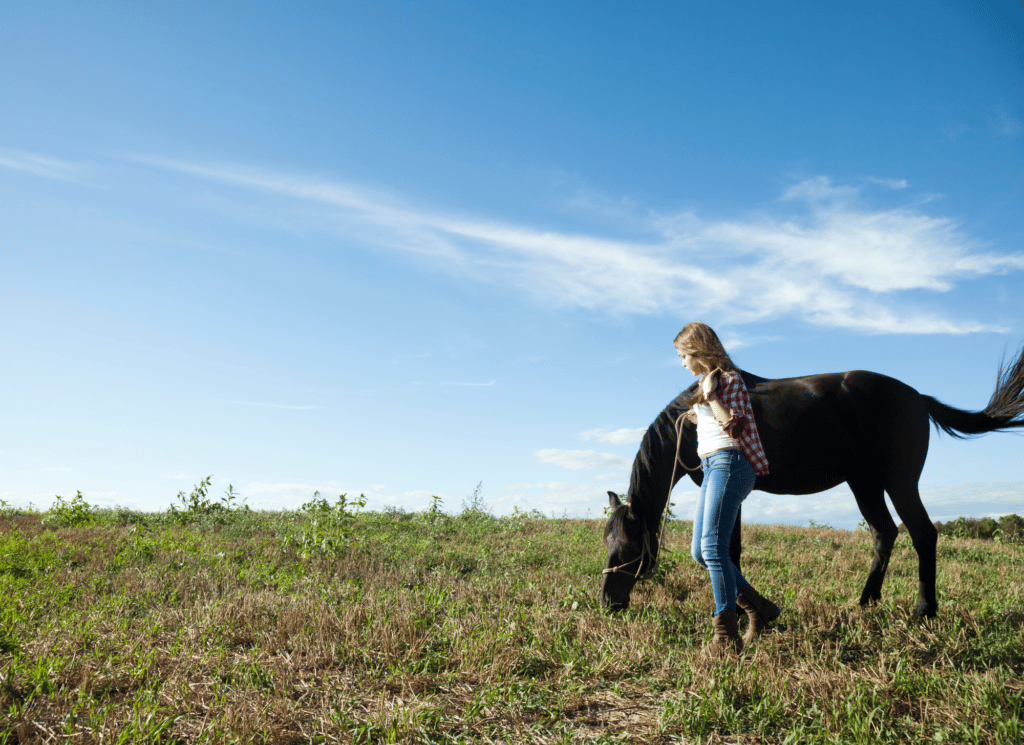
What to Do When Your Horse Has Impaction Colic
When you suspect your horse is coming down with impaction colic, it’s essential to stay calm. Take the following steps to help treat your horse and avoid further complications:
- Get Them Up
If your horse has been lying down and is able to get up, help them up, keep a halter on them, and prevent them from lying down or rolling.
- Take Vital Signs
Use a digital thermometer to take your horse’s temperature. If your horse has a temperature of more than 104℉, they have a fever.
Note the color of the horse’s gums and the inside of their eyelids. If these areas aren’t salmon pink, the horse may be suffering from circulatory issues. Yellow gums or eyes mean the red blood cells are breaking down, causing anemia. Pale gums and eyelids are a sign of dehydration and poor circulation.
Look for signs of heaving with contracted muscles running down their abdomen in spasms.
- Encourage Gentle Movement
Help ease your horse’s distress and pain with gentle hand walking, stopping frequently to let the horse rest. If the horse’s symptoms of colic are not showing signs of easing, it’s time to call your veterinarian immediately.
What NOT to Do When Your Horse Has Impaction Colic
Don’t syringe water or oil into their throat to try and “wet” the gut. It won’t work, and your risks of getting fluid into the horse’s lungs far outweigh any potential benefits.
Your horse is in pain, so don’t force them to walk or run to try and “run it off.” Don’t encourage them to eat anything other than natural grazing. Don’t try to perform a rectal examination on your horse.

What Treatment Will Your Veterinarian Give for Impaction Colic?
When you call your vet out, the first thing they will do is check vital signs, assess what the visible extent of the colic is, and listen to the gut for sounds and palpitate for any swelling.
If they suspect the colic is mild enough, they will proceed to give an anti-inflammatory injection like bute as well as an antispasmodic like Buscopan.
If there is no improvement in a few hours and the horse doesn’t pass stool, they may recommend a rectal examination to physically assess where the blockage may lie. The vet may also insert a nasogastric tube and pump water with a lubricant-like glycerin into the digestive tract in an attempt to flush the blockage.
Should there be no improvement of the clinical signs, the vet may recommend a sonar examination followed by X-rays, and if necessary, surgery may be the last option. If a twisted gut is suspected, a surgery is the only option.
When and Why Is It Time to Call Your Vet?
You should call your vet if mild walking doesn’t improve the colic signs within a few minutes or if there’s noticeable worsening. Follow my motto: When in doubt, call the vet.
Vets have access to much more equipment and medical knowledge than the average horse owner will ever have. They know what they can and can’t do, and if it’s unfeasible to perform surgery, they will be able to help you make the call to end your horse’s suffering.
Impaction colic in horses is never a pleasant experience for the owner or horse. Considering that colic is the number one cause of death among horses, it’s no wonder that when your horse has colic, it’s always something to take seriously.
Perhaps your horse has contracted sand colic or gas colic. Never assume you can make a diagnosis without the aid of your vet. They are there to protect your horse from harm and prevent unnecessary pain and suffering.
Read more about sand colic and make sure you are informed about all forms of colic.
Like this post? Save it on Pinterest. Follow me on Pinterest.
